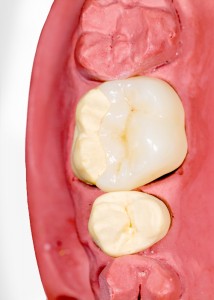Restoring Back Teeth – Crowns, Onlays and Inlays Explained
 The cusp is the pointed or rounded projection on the chewing surface of the tooth. Molars typically have four cusps (as shown in the top tooth to the right). Bicuspids, also called pre-molars, typically have two cusps (as shown in the bottom tooth to the right). When we refer to crowns, onlays, and inlays, we are referring to whether we need to restore the cusp of the tooth, and if so, whether it is all of the cusps or some of the cusps. When a tooth has been severely weakened or fractured, we will usually place a crown, which covers all of the cusps.
The cusp is the pointed or rounded projection on the chewing surface of the tooth. Molars typically have four cusps (as shown in the top tooth to the right). Bicuspids, also called pre-molars, typically have two cusps (as shown in the bottom tooth to the right). When we refer to crowns, onlays, and inlays, we are referring to whether we need to restore the cusp of the tooth, and if so, whether it is all of the cusps or some of the cusps. When a tooth has been severely weakened or fractured, we will usually place a crown, which covers all of the cusps.
When a tooth has one or more cusps that are weakened or fractured but other cusps that are still strong, we can elect to do an onlay. An onlay can cover one or more cusps while retaining some of the tooth above the gumline. In the example photo, the two cusps on the left were determined to be too weak and were capped, but the remaining cusps were healthy so they were left untouched. The tooth on the bottom needed a complete crown.
When the cusps of the tooth are all healthy and structurally sound, we can elect to restore the surrounding structure but leave the cusps intact. This is called an inlay.


